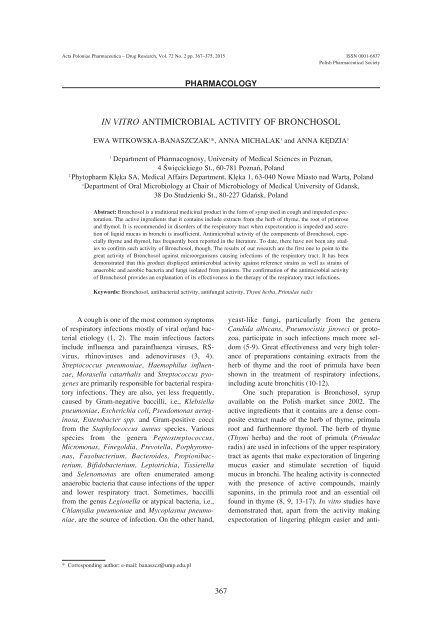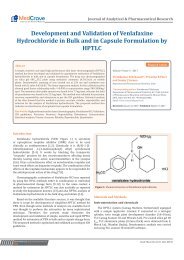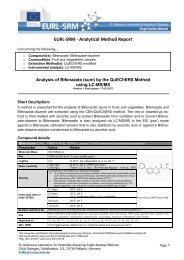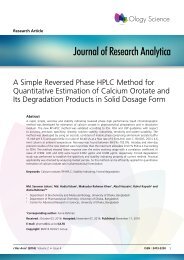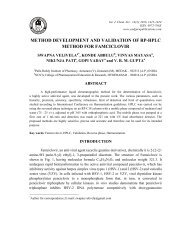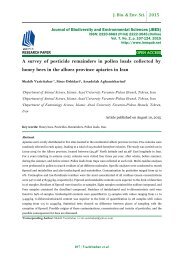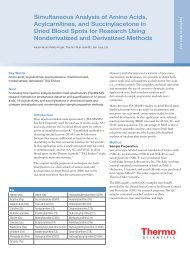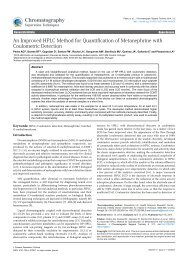acta 2_2015
acta 2_2015
acta 2_2015
- No tags were found...
You also want an ePaper? Increase the reach of your titles
YUMPU automatically turns print PDFs into web optimized ePapers that Google loves.
Acta Poloniae Pharmaceutica ñ Drug Research, Vol. 72 No. 2 pp. 367ñ375, <strong>2015</strong> ISSN 0001-6837Polish Pharmaceutical SocietyPHARMACOLOGYIN VITRO ANTIMICROBIAL ACTIVITY OF BRONCHOSOLEWA WITKOWSKA-BANASZCZAK 1 *, ANNA MICHALAK 1 and ANNA K DZIA 31Department of Pharmacognosy, University of Medical Sciences in Poznan,4 åwiÍcickiego St., 60-781 PoznaÒ, Poland2Phytopharm KlÍka SA, Medical Affairs Department, KlÍka 1, 63-040 Nowe Miasto nad Wartπ, PolandcDepartment of Oral Microbiology at Chair of Microbiology of Medical University of Gdansk,38 Do Studzienki St., 80-227 GdaÒsk, PolandAbstract: Bronchosol is a traditional medicinal product in the form of syrup used in cough and impeded expectoration.The active ingredients that it contains include extracts from the herb of thyme, the root of primroseand thymol. It is recommended in disorders of the respiratory tract when expectoration is impeded and secretionof liquid mucus in bronchi is insufficient. Antimicrobial activity of the components of Bronchosol, especiallythyme and thymol, has frequently been reported in the literature. To date, there have not been any studiesto confirm such activity of Bronchosol, though. The results of our research are the first one to point to thegreat activity of Bronchosol against microorganisms causing infections of the respiratory tract. It has beendemonstrated that this product displayed antimicrobial activity against reference strains as well as strains ofanaerobic and aerobic bacteria and fungi isolated from patients. The confirmation of the antimicrobial activityof Bronchosol provides an explanation of its effectiveness in the therapy of the respiratory tract infections.Keywords: Bronchosol, antibacterial activity, antifungal activity, Thymi herba, Primulae radixA cough is one of the most common symptomsof respiratory infections mostly of viral or/and bacterialetiology (1, 2). The main infectious factorsinclude influenza and parainfluenza viruses, RSvirus,rhinoviruses and adenoviruses (3, 4).Streptococcus pneumoniae, Haemophilus influenzae,Moraxella catarrhalis and Streptococcus pyogenesare primarily responsible for bacterial respiratoryinfections. They are also, yet less frequently,caused by Gram-negative baccilli, i.e., Klebsiellapneumoniae, Escherichia coli, Pseudomonas aeruginosa,Enterobacter spp. and Gram-positive coccifrom the Staphylococcus aureus species. Variousspecies from the genera Peptostreptococcus,Micromonas, Finegoldia, Prevotella, Porphyromonas,Fusobacterium, Bacteroides, Propionibacterium,Bifidobacterium, Leptotrichia, Tissierellaand Selenomonas are often enumerated amonganaerobic bacteria that cause infections of the upperand lower respiratory tract. Sometimes, baccillifrom the genus Legionella or atypical bacteria, i.e.,Chlamydia pneumoniae and Mycoplasma pneumoniae,are the source of infection. On the other hand,yeast-like fungi, particularly from the generaCandida albicans, Pneumocistis jiroveci or protozoa,participate in such infections much more seldom(5-9). Great effectiveness and very high toleranceof preparations containing extracts from theherb of thyme and the root of primula have beenshown in the treatment of respiratory infections,including acute bronchitis (10-12).One such preparation is Bronchosol, syrupavailable on the Polish market since 2002. Theactive ingredients that it contains are a dense compositeextract made of the herb of thyme, primularoot and furthermore thymol. The herb of thyme(Thymi herba) and the root of primula (Primulaeradix) are used in infections of the upper respiratorytract as agents that make expectoration of lingeringmucus easier and stimulate secretion of liquidmucus in bronchi. The healing activity is connectedwith the presence of active compounds, mainlysaponins, in the primula root and an essential oilfound in thyme (8, 9, 13-17). In vitro studies havedemonstrated that, apart from the activity makingexpectoration of lingering phlegm easier and anti-* Corresponding author: e-mail: banaszcz@ump.edu.pl367


